Latest News
Nat Sciver-Brunt century drives England to imposing 178-run victory

Nat Sciver Brunt once again proved herself to be the gold standard of England’s batting with a mighty 117-ball 124 not out, then followed up with two game-breaking wickets in her first bowl of the summer, as England powered to an emphatic 178-run victory in the third and final ODI against Pakistan at Chelmsford.
The result, achieved under mercifully rain-free skies after the sodden mess that engulfed Sunday’s second match at Taunton, condemned Pakistan to a 2-0 series loss in the 50-over leg of their tour, to go along with their 3-0 whitewashing in the T20Is. And, in a welcome sign of progress for the hosts after last week’s “scrappy” 37-run victory at Derby, this was England’s most complete display of their five completed matches, with Pakistan’s innings this time mopped up with more than 20 overs to spare.
With England’s imposing 302 for 5 on the board, Pakistan were reduced to 35 for 3 in the powerplay by the returning Lauren Bell, who bagged both openers in the space of ten balls including Sidra Amin to a sharp take from Maia Bouchier at cover, and Kate Cross, who induced Ayesha Zafar into a flat flick to midwicket for 13. Then, after Sciver-Brunt had signalled her return to bowling fitness with the scalps of Najiha Alvi for 6 and Muneeba, caught off a top-edge for a battling 47 from 55 balls off the final ball of her designated five-over spell, it was over to Sophie Ecclestone with a slice of history of her own.
The world’s No.1 spin bowler is a handy operator to be able to introduce at 96 for 6 after 21 overs, after Charlie Dean had been rewarded for her own perseverance by picking off Fatima Sana for a third-ball duck. She duly mopped up the resistance with three wickets in 25 balls, including two in two to march through to 100 ODI wickets in her 64th match – the quickest in women’s ODI history – with her captain Heather Knight grabbing Nashra Sandhu at slip for the landmark wicket.
With Nida Dar unable to bat after tweaking her hamstring in the field, it was left to England’s substitute fielder Sophia Dunkley to wrap up the contest with more than 20 overs remaining, with a sharp tumbling take at long-off that ended Aliya Riaz’s doughty innings of 36 from 41.
Her ninth ODI hundred was her fourth in nine innings and tenth in all formats for England, and also took her past 3,500 ODI runs in her 94th innings, at a faster rate than any female batter in history. Her only genuine let-off came on 86, when Najiha Alvi spilled a thin edge off Nashra that could also have been a stumping chance but, unfazed, she banked her century from 110 balls with back-to-back scoops for four off Sana, before truly cutting loose to apply a gloss finish to the innings. Diana Baig’s final over was clattered for consecutive straight sixes and another lofted four through the covers, as England ransacked 47 runs from the final three overs.
It hadn’t started with quite such poise, however. After winning the toss and batting first, England once again endured a mixed powerplay against some probing new-ball bowling and were three-down for 70 inside the 14th over. In particular, Tammy Beaumont’s dismissal to an ill-conceived ramp shot epitomised a team that is determined to dial up their aggression with the T20 World Cup looming, but has struggled to “read the situations” of a 50-over innings that Knight had identified as their key challenge in the lead-up to the series.
Bouchier impressed with her poise initially, picking off six fours to provide the bulk of England’s early progress, but her 34 from 33 balls still ended up being her highest score of a series that had promised more. But after Knight had come and gone cheaply, Danni Wyatt took over the initiative in a fourth-wicket stand of 79 with a 42-ball 44, before Amy Jones capitalised on a let-off at midwicket on 6 to keep the innings ticking with a run-a-ball 27.
Alice Capsey then kept Sciver-Brunt company into the death overs with 39 not out from 42 balls, including a one-bounce four down the ground moments after overturning an lbw appeal that was shown to be going over the stumps. Thereafter she was limited to just one more boundary in her first 37 balls until a late brace in the final over, as Pakistan tightened their lines to briefly raise the prospect of limiting England to a total closer to 250 than 300.
But by the time England’s premier performer had trotted out her A-game in the closing moments, there was no way back for Pakistan.
Brief scores: England 302 for 5 in 50 overs (Maia Boucher 34, Nat Sciver-Brunt 124*, Danni Wyatt 44, Amy Jones 27, Alice Capsey 39*; Diana Baig 1-60, Nida Dar 1-51, Fatima Sana 1-57, Umrp-e-Hani 2-47) beat Pakistan 124 in 29.1 overs (Muneeba Ali 47, Alia Riaz 36; Kate Cross 1-19, Lauren Bell 2-26, Charlie Dean 1-47, Nat Sciver-Brunt 2-11, Sophie Ecclestone 3-15) by 78 runs
(Cricinfo)
Latest News
Tourists and residents evacuated as volcano erupts in Iceland
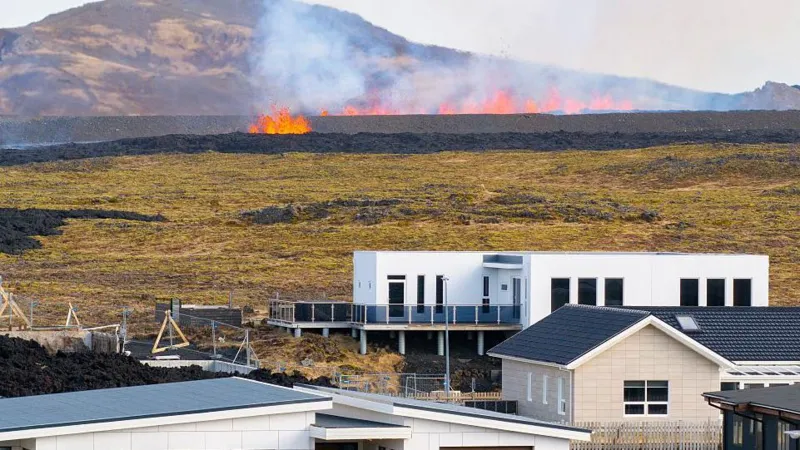
Tourists and residents have been evacuated as a volcano erupted in south-west Iceland, threatening a town and popular attraction.
The volcano has been spewing lava and smoke in a fiery display of orange and red since the eruption began in the morning, creating a huge crack in the ground which has grown to 1.2km (0.75 miles) long.
Multiple earthquakes have occurred in the volcanic area throughout the day.
The volcano is close to the fishing town of Grindavik and the famous Blue Lagoon spa. A small number of people refused to evacuate the town, local media reported.
People were asked to “leave the danger zone,” the region’s police commissioner, Ulfar Ludviksson, told Iceland’s RUV broadcaster. But he said individuals staying in “seven or eight houses there… have decided to remain in the town.”
There were fears that the town was “in danger of having lava flows entering the inhabited area”, said Rikke Pedersen from the Nordic Volcanological Centre.
A hot water pipe has broken in the northern part of Grindavík, which confirms that considerable cracking has occurred within the town, the Icelandic Meteorological Office (IMO) said.
The protective barriers around Grindavik have also been breached, as new eruptive fissure opened a few hundred meters inside, the IMO reported. But volcanic activity eased off in the early afternoon on Tuesday.
Roads in and out of the town remain closed, but flights are currently not affected.
Most of the 4,000 residents of Grindavík left in a mass evacuation in 2023 because of the dangers of the volcanic activity. The volcano has erupted several times since.
The length of the magma that formed on Tuesday under the crater series stretched to about 11 km (6.8 miles) – the longest that has been measured since 11 November 2023, meteorologists said. The magma corridor extends about 3km further northeast than seen in previous eruptions.
Based on current wind direction, gas pollution from the eruption will travel northeast towards the capital area, the IMO added.
The eruption, which began around 09.45 local time (10:45 BST), occurred after several earthquakes hit the area known as the Sundhnúk crater range.
Multiple eruptions have occurred on the Reykjanes Peninsula since 2021. The last time the peninsula had a period of volcanic activity was 800 years ago – and the eruptions continued for decades.
Iceland has 33 active volcano systems and sits over what is known as the Mid-Atlantic Ridge, the boundary between two of the largest tectonic plates on the planet.
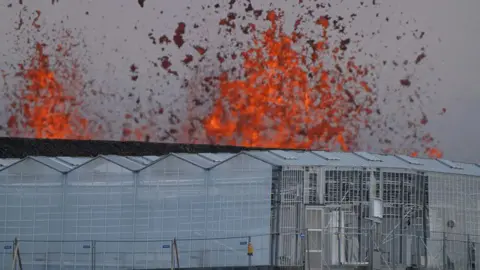
[BBC]
Latest News
Mandalay was the ‘city of gold’ – now it reeks of death
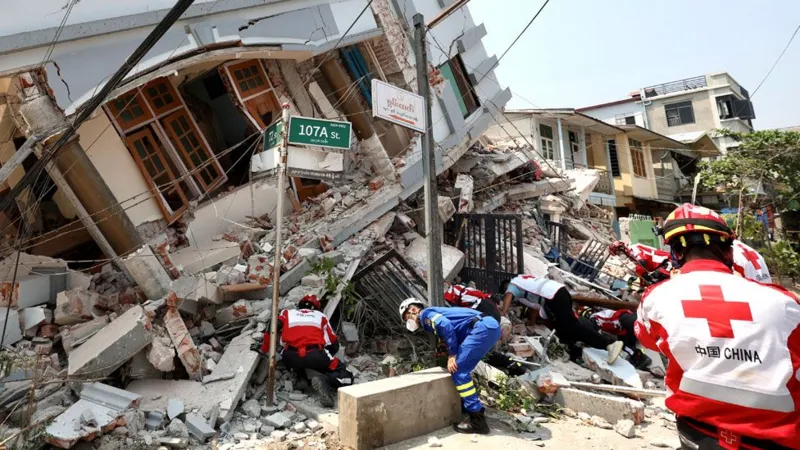
Mandalay used to be known as the city of gold, dotted by glittering pagodas and Buddhist burial mounds, but the air in Myanmar’s former royal capital now reeks of dead bodies.
So many corpses have piled up since a 7.7 magnitude earthquake struck last Friday close to Mandalay, that they have had to be “cremated in stacks”, one resident says.
The death toll from the quake and a series of aftershocks has climbed past 2,700, with 4,521 injured and hundreds still missing, Myanmar’s military chief said. Those figures are expected to rise.
Residents in the country’s second most populous city say they have spent sleepless nights wandering the streets in despair as food and water supplies dwindle.
The Mandalay resident who spoke of bodies being “cremated in stacks” lost her aunt in the quake.
“But her body was only pulled out of the rubble two days later, on 30 March,” said the 23-year-old student who wanted only to be known as J.
Poor infrastructure and a patchwork of civil conflicts are severely hampering the relief effort in Myanmar, where the military has a history of suppressing the scale of national disasters. The death toll is expected to keep rising as rescuers gain access to more collapsed buildings and cut-off districts.
J, who lives in Mandalay’s Mahaaungmyay district, has felt “dizzy from being deprived of sleep”, she said.
Many residents have been living out of tents – or nothing – along the streets, fearing that what’s left of their homes will not hold up against the aftershocks.
“I have seen many people, myself included, crouching over and crying out loud on the streets,” J said.
But survivors are still being found in the city. The fire service said it had rescued 403 people in Mandalay in the past four days, and recovered 259 bodies. The true number of casualties is thought to be much higher than the official version.
In a televised speech on Tuesday, military chief Min Aung Hlaing said the death toll may exceed 3,000, but the US Geological Survey said on Friday “a death toll over 10,000 is a strong possibility” based on the location and size of the quake.
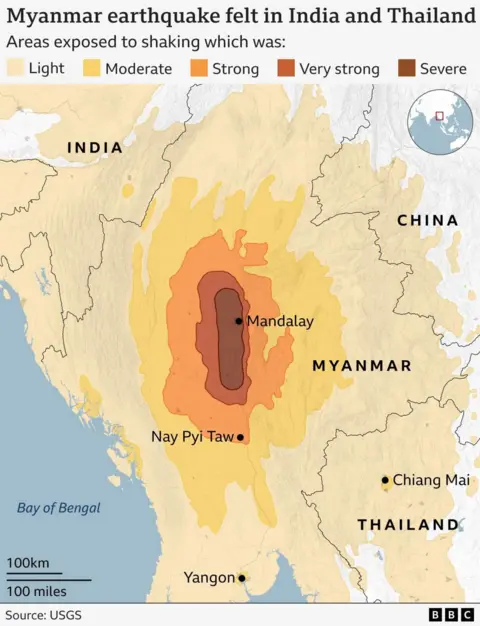
Young children have been especially traumatised in the disaster.
A local pastor told the BBC his eight-year-old son had burst into tears all of a sudden several times in the last few days, after witnessing parts of his neighbourhood buried under rubble in an instant. “He was in the bedroom upstairs when the earthquake struck, and my wife was attending to his younger sister, so some debris had fallen onto him,” says Ruate, who only gave his first name. “Yesterday we saw bodies being brought out of collapsed buildings in our neighbourhood,” said Ruate, who lives in the Pyigyitagon area.
“It’s very sobering. Myanmar has been hit by so many disasters, some natural, some human made. Everyone’s just gotten so tired. We are feeling hopeless and helpless.”
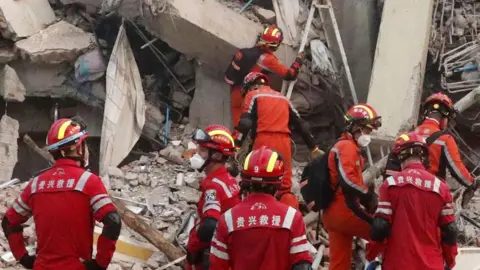
A monk who lives near the Sky Villa condominium, one of the worst-hit buildings reduced from 12 to six storeys by the earthquake, told the BBC that while some people had been pulled out alive, “only dead bodies have been recovered” in the past 24 hours. “I hope this will be over soon. There are many bodies still inside, I think more than a hundred,” he said.
Crematoriums close to Mandalay have been overwhelmed, while authorities have been running out of body bags, among other supplies, including food and drinking water.
Around the city, the remains of crushed pagodas and golden spires line the streets. While Mandalay used to be a major centre for the production of gold leaf and a popular tourist destination, poverty in the city has soared in recent years, as with elsewhere in Myanmar (formerly called Burma).
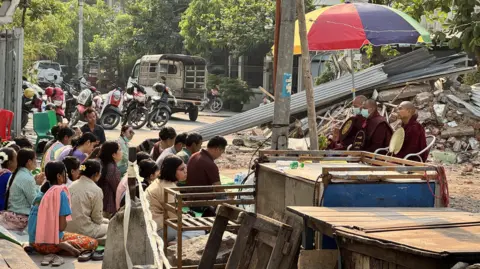 BBC Burmese
BBC BurmeseLast week’s earthquake also affected Thailand and China, but itsnimpact has been especially devastating in Myanmar, which has been ravaged by a bloody civil war, a crippled economy and widespread disillusionment since the military took power in a coup in 2021.
On Tuesday, Myanmar held a minute of silence to remember victims, part of a week of national mourning. The junta called for flags to fly at half mast, media broadcasts to be halted and asked people to pay their respects.
Even before the quake, more than 3.5 million people had been displaced within the country.
Thousands more, nany of them young people, have fled abroad to avoid forced conscription – this means there are fewer people to help with relief work, and the subsequent rebuilding of the country.
Russia and China, which have helped prop up Myanmar’s military regime, are among countries that have sent aid and specialist support.
But relief has been slow, J said.
“The rescue teams have been working non-stop for four days and I think they are a little tired. They need some rest as well.
“But because the damage has been so extensive, we have limited resources here, it is simply hard for the relief workers to manage such massive destruction efficiently,” she said.

While the junta had said that all assistance is welcome, some humanitarian workers have reported challenges accessing quake-stricken areas.
Local media in Sagaing, the earthquake’s epicentre, have reported restrictions imposed by military authorities that require organisations to submit lists of volunteers and items that they want to bring into the area.
Several rights groups, including Human Rights Watch and Amnesty International, have urged the junta to allow aid workers immediate access to these areas.
“Myanmar’s military junta still invokes fear, even in the wake of a horrific natural disaster that killed and injured thousands,” said Bryony Lau, Human Rights Watch’s deputy Asia director.
“The junta needs to break from its appalling past practice and ensure that humanitarian aid quickly reaches those whose lives are at risk in earthquake-affected areas,” she said.
The junta has also drawn criticism for continuing to open fire on villages even as the country reels from the disaster.
[BBC]
Latest News
PM visits France to attend high-level conference at UNESCO

The Prime Minister of Sri Lanka Dr. Harini Amarasuriya is on an official visit to Paris, France to participate in the high-level segment of the International Expert Conference on ’An Integrated and Sustainable Approach to Safeguarding the World Heritage Property of the Sacred City of Anuradhapura in Sri Lanka and Associated Living Heritage’ which was to be held at UNESCO Headquarters today [Tuesday 1 April], with the participation of the Director-General of UNESCO Audrey Azoulay.
The Conference, organized by UNESCO in partnership with Sri Lanka, brings together leading international experts to discuss sustainable strategies for the conservation of Anuradhapura, a UNESCO World Heritage Site of immense cultural and historical significance.
On the sidelines of the Conference, the Prime Minister is also scheduled to meet senior interlocutors of the French Government to discuss bilateral cooperation and areas of mutual interest.
The Delegation of the Prime Minister includes the Minister of Buddhasasana Religious and Cultural Affairs, Dr. Hiniduma Sunil Senevi.
[Prime Minister’s Media Division]
-

 Sports3 days ago
Sports3 days agoSri Lanka’s eternal search for the elusive all-rounder
-

 Features7 days ago
Features7 days agoCelebrating 25 Years of Excellence: The Silver Jubilee of SLIIT – PART I
-

 News4 days ago
News4 days agoGnanasara Thera urged to reveal masterminds behind Easter Sunday terror attacks
-

 Business7 days ago
Business7 days agoCEB calls for proposals to develop two 50MW wind farm facilities in Mullikulam
-

 Business5 days ago
Business5 days agoAIA Higher Education Scholarships Programme celebrating 30-year journey
-

 Features7 days ago
Features7 days agoNotes from AKD’s Textbook
-

 News2 days ago
News2 days agoBid to include genocide allegation against Sri Lanka in Canada’s school curriculum thwarted
-

 News3 days ago
News3 days agoComBank crowned Global Finance Best SME Bank in Sri Lanka for 3rd successive year























